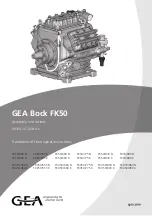
F
OR
M
ODELS
: JGI, JGM, JGN, JGP
AND
JGQ
S
ECTION
5 - M
AINTENANCE
PAGE 5-34
Piston Rod Packing - Reassembly
1.
Be sure to refer to the pressure packing assembly in the Ariel Parts Book.
Please contact your distributor if you do not have a Parts Book. A pressure
packing assembly drawing also is packaged with each pressure packing re-build
kit.
2.
Care must be taken to prevent scratching the mating surfaces of the cups, which
can cause problems. Cup surfaces must be clean and dry when being
re-assembled.
3.
If installing a new set of rod rings in an existing packing case, the case parts
need to be inspected for wear. Cups should be smooth and flat on the back side
where the rod rings must seal. If the cups or grooves have worn concave or
tapered, they should be reground or relapped. Do not reduce the cup thickness
to less than the rework dimension shown on the packing assembly drawing in
the Ariel Parts Book. It is rarely necessary to alter the crosshead side of the
cups, however, if this is found necessary, care must be taken so that the correct
side clearance for the renewal rings is not destroyed.
NOTE: IF PREMATURE WEAR IS SUSPECTED, REFER TO THE ARIEL "LUBE TYPE &
RATE RECOMMENDATIONS" ON PAGE 4-26.
4.
Before a packing case is installed, it should always be disassembled and thor-
oughly cleaned in an appropriate solvent for the intended service.
5.
Before assembling the rings into the case, the following is recommended: Put
each ring set individually onto the rod and check the total end gap. See “Types
of Piston Rod Packing Rings” on page 5-35 for end gap tolerances. File at a gap
to restore total end gap within tolerance. With the ring set on the rod, shine a
light from behind the ring, if any light is observed between the ring and the rod,
the ring set is not acceptable.
6.
Make sure that each rod ring and cup is properly positioned and that rings are
liberally coated with a clean lubricant before reassembly. Only use the same
lubricant that is used in the force feed lube system. Examine all parts for unusual
nicks or burrs which might interfere with the free floating of the rod ring in the
cups. Particular care should be taken with rod rings made of soft materials, such
as bronze or TFE, and it is extremely important that wiper rings be handled and
installed so as to prevent damage to the scraping edges.
7.
Parts should be laid out on a work bench so that they can be installed progres-
sively with each in its correct position and the rod rings with their proper faces
toward the pressure. Be sure that the tie studs are completely screwed into the
end cup. The stud holes are not equally spaced. This prevents the stack of parts
from being aligned incorrectly. Note that all rod ring segments are carefully let-
tered and must be assembled accordingly. This is most important for proper
sealing. Center, side-loaded AL rings prior to tightening tie stud nuts. Tighten the
tie stud nuts to the recommended torque value given in Table 1-12 on page
1-16. Make sure that all rings move freely, radially, in their grooves using your
fingers. Side loaded rings will be snug, but should still move using your fingers.
Be sure these rings are centered. If the packing is water cooled, see
“Water-Cooled Piston Rod Packing” on page 5-38.
8.
For new installations, care must be given to the cleaning of all accumulated dirt
in the lines and compressor because foreign material will lodge in the packing to
become destructively abrasive. Refer to "Oil System Cleanliness" on Page 4-15.
















































